

Why is There No Room for Hispanics On Corporate Boards?
For the seventh consecutive year, the percent of directors of Hispanic origin elected to Fortune 500 boards was sharply lower than the overall representation of Hispanics in the U.S. population, according to the Heidrick & Struggles 2016 board monitor.
Of 399 new directors appointed by Fortune 500 companies in 2015, only 16 were Hispanic — a measly four percent. Over the past seven years, an average of 4.7 percent of new directors have been Hispanic. That dire statistic reveals there has been no discernible upward trend. Nothing. As the Hispanic share of the U.S. population has grown during those years, the gap of under-representation in the boardroom has therefore widened…
Link to article
Organization Advocates for More Latinos On Corporate Boards
WASHINGTON, DC — It is an absolute business imperative to have Latinos and Latinas in leadership positions in the business world, particularly on the boards of the country’s top companies, where the numbers remain dismally low. That was the focus of a recent gathering here of many of the nation’s business leaders to commemorate three decades of the Hispanic Association on Corporate Responsibility (HACR), an organization that advocates for a greater number of Hispanics in corporate America.
Just over 7 percent of Latinos hold board seats among Fortune 500 companies, and just 4 percent of all executive positions…
Link to article
8 Latino business founders breaking down barriers
Making their million-dollar mark
Latino-founded businesses are booming, yet less than 2 percent of Latino entrepreneurs ever make it past the $1 million revenue mark, according to the U.S. Census Bureau. Of the 1.4 million Latino-owned companies in the United States, the average has $156,000 in annual sales, revealed a study from the Latin Business Action Network (LBAN)…
Link to article
Why so few Latino-owned businesses get venture capital funding
In the world of venture capital, Latino-owned businesses are rarer than billion dollar unicorns.
Only about 1% of all Latino-owned businesses created between 2007 and 2012 in the U.S. received venture capital or angel investments, according to a report by the Stanford Graduate School of Business that surveyed roughly 1,800 businesses.
One big reason: Very few Latino-owned firms are even walking through the doors of venture capital firms to begin with…
Link to article
5 Reasons Brands Should Use Facebook Instant Articles To Engage With U.S. Hispanics
Last month, Facebook announced that on April 12, they will be “opening up the Instant Articles program to all publishers—of any size, anywhere in the world.” Yes, this means that brands can now leverage Facebook Instant Articles to engage with consumers.
Facebook created Instant Articles to optimize the experience for users who click from Facebook to a third-party publisher’s website on their mobile devices. For brands, Instant Articles not only optimize page load times, but can be leveraged to create more immersive experiences that are integrated with the all-important Facebook news feed…
Link to article
Community Voices: Latinas working to empower each other
When it comes to Latinas, it seems that all eyes are not only placed on women such as Jennifer Lopez, Selena Gomez or Sofia Vergara. Throughout the entire country, the number of Hispanic women is growing and so are organizations and companies that focus on the growth of Latinas…
Link to article
Job Opportunities for Latinos — Marketing Specialist
Information is the key to success these days especially in business. Most companies, entrepreneurs and organization are even willing to spend millions just to gather important details they can use to know more and understand their customers. That’s why jobs that are inclined to its niche, like Market Specialists, have a projected demand increase of about 41 percent from 2010 to 2020…
Link to article
From Undocumented to Goldman Sachs Exec: Julissa Arce’s Amazing Story
NEW YORK, NY — A job at the investment bank Goldman Sachs is one of the most prized positions in the country. The company prides itself on attracting some of America’s most talented professionals—ambitious, smart and highly motivated. Many people would probably be very surprised to discover that at least one undocumented Mexican immigrant was working shoulder to shoulder with the country’s corporate elite.
Former Goldman Sachs vice president Julissa Arce, 32, wants to change the way Americans think about immigration by sharing her story. And in her upcoming September 2016 memoir, “My (Underground) American Dream,” she aims to describe her long and difficult journey from undocumented to documented, which took her from selling funnel cakes in Texas to Wall Street…
Link to article
From the Delano Grape Strike to the Mexican American Vintners Association
By Humberto Gutierrez
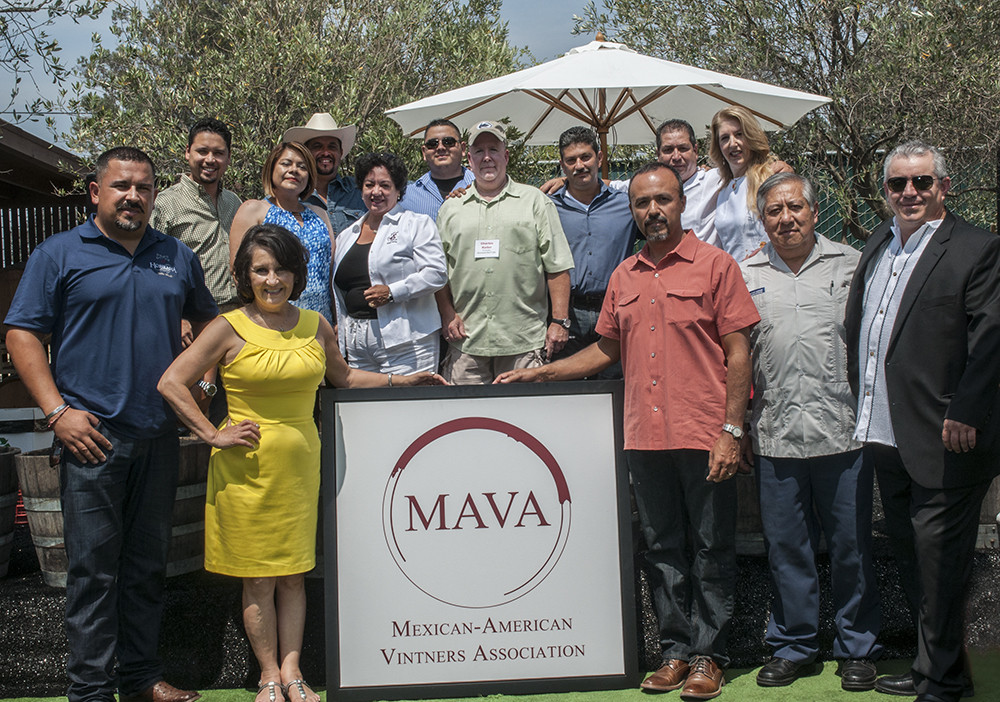
There have been several longitudinal studies on Mexican American mobility showing that although the monetary movement of Mexican Americans is not quite as rapid as that of whites, there is still a steady accumulation of wealth across generations.
This mobility is evidenced by the progress made by Mexican American professionals. As evidence of this success, we have witnessed the birth of several prominent professional associations. Most notable are:
- MAES, Latinos in Science and Engineering
- AMAE, Association of Mexican American Educators
- MABA, Mexican American Bar Association
- SACNAS, Society for Advancement of Chicanos and Native Americans in Science
- MAHPA, Mexican American Hispanic Physicians Association
- MABPA, Mexican American Business and Professional Association
- MALFA, Mexican American Latino Faculty Association
- MAVA, Mexican American Vintners Association
The latest American Community Survey shows year-to-year progress, or lack of it, on the survey’s annual census.
Prominent among this year is the continued progress of Mexican American college enrollment, which has jumped from 18.1% in 2013 to 18.7% in 2014. Unfortunately, graduate or professional degrees remain low with a small gain. For 2013, the graduate or professional degree was 11.2% and for 2014 this percentage climbed to 11.4% for the total population, while for 2013 it was 2.8% for Mexican Americans, and 2.9% for 2014.

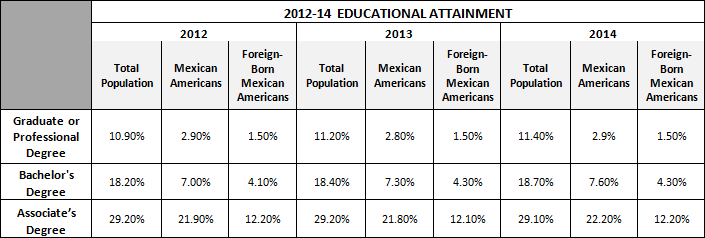
Occupations in management, business, science, and arts showed a nice increase for Mexican Americans, from 16.7% to 17.4% while for the total population percentages went from 36.3% in 2013 to 36.9% in 2014. Mexican Americans still lag far behind the total population but there is a slight gain as compared to the total population.

For industry, numbers have gone up slightly for the total population but have remained stagnant for Mexican Americans.
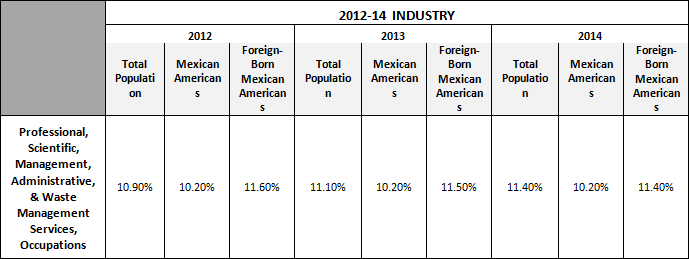
References
- Census Bureau, Selected Population Profile in the United States: 2014
- United States S0201 and B05006. Selected Population Profile in the United States
- Population Groups: Mexican and Mexico (foreign-born)
- Data Set: American Community Survey 1-Year Estimates for years 2012 and 2014
- Census Bureau, American Fact Finder, Selected Population Profile in the United States
Declining Ratings for Mexico’s Peña Nieto
Three years after being elected president, Mexico’s Enrique Peña Nieto is increasingly unpopular. Following a year plagued by scandal and controversy, his ratings have fallen, and Mexicans have grown disappointed with key elements of his ambitious agenda…
Link to article
A Comparatie Study of the Perceived Housing Needs of Low-income and Upper-Middle-income Residents of San Jose California
A Mazur – 2015
… B. Neighborhoods. IV. Mexican-Americans and the Elderly. A. Physical Structures. … While only
5’1 of the housing units occupied by non-Mexican-American whites were unsound in I960, 23′,
of the units occupied by Mexican-Americans were unsound. Overcrowding was …
Link to report
Mayor Nelda Martinez, Woman of Distinction
Corpus Christi Mayor Nelda Martinez was honored by the Texas Association of Mexican American Chambers of Commerce at the 4th annual Women of Distinction Awards in Austin.
Mayor Martinez was one of 12 Latinas from across the state that was recognized for their professional accomplishments, community contributions, and leadership. “I am humbled and honored to receive this recognition from such a prestigious state organization as The Texas Association of Mexican American…
Link to article
Joe Debro on racism in construction, Part 10: The Mexican American al laborer and entrepeneur(continued)
A 1968 book-length report, titled “A Study of the Manpower Implications of Small Business Financing: A Survey of 149 Minority and 202 Anglo-Owned Small Businesses in Oakland, California,” was sent to the Bay View by its author, Joseph Debro, prior to his death in November 2013, and his family has kindly permitted the Bay View to publish it. The survey it’s based on was conducted by the Oakland Small Business Development Center, which Debro headed, “in cooperation with the small businessmen of Oakland, supported in part by a grant, No. 91-05-67-29, from the U.S. Department of Labor, Manpower Administration, Office of Manpower, Policy, Evaluation and Research.” Project co-directors were Jack Brown and Joseph Debro, and survey coordinator was Agustin Jimenez. The Bay View is publishing the report as a series. A prolog appeared in the December 2013 Bay View, Part 1 in January 2014, Part 2 in February, Part 3 in April, Part 4 in May, Part 5 in June, Part 6 in August, Part 7 in October, Part 8 in November, Part 9 in January 2015 and this is Part 10 of the report…
Link to article
The Mexican Museum Hires Cayetana S. Gómez as President and Chief Executive Office
Gómez to oversee operations, capital campaign, cultural relations, and collections
SAN FRANCISCO, CA — January 27, 2015 — The Mexican Museum (Museum), the premier West Coast museum of Mexican, Mexican-American, Chicano, and Latino art, culture and heritage, announces that Cayetana S. Gómez has been hired as President and Chief Executive Officer (CEO). Gómez will be responsible for overseeing business operations for the Museum’s current location at Fort Mason Center. She will also be implementing the business and strategic plans for the cultural component of the 706 Mission Street Residential and Mexican Museum project, which will serve as the Museum’s future home in the heart of the Yerba Buena Gardens Art District.
“We are extremely pleased to have Cayetana join our team,” said Andrew M. Kluger, Chairman of The Mexican Museum Board of Trustees. “Along with her unparalleled communication skills and a vast network of professional relationships throughout the United States and Mexico, she has also held significant leadership positions for some of Mexico’s…
Link to article
Shumaker Loop names first Hispanic managing partner
Julio Esquivel, partner and a member of the management committee at Shumaker Loop & Kendrick LLP, is about to make history in the company.
Esquivel will be the firm’s next managing partner, taking over for J. Todd Timmerman, and will be the first Hispanic managing partner in the firm’s history.
Esquivel specializes in corporate law with a focus on mergers and acquisitions, securities, IPOs, franchise and distribution, and international transactions. He’s been a member of Shumaker Loop for 17 years, and said Partner Greg Yadley was his mentor from the start at the firm…
Link to article
Mexican professionals bringing ambition, startups to North Texas
Dallas Morning News
A cocktail mixer sponsored by the Association of Mexican Entrepreneurs …. “Americans respect power, and that’s what we’re striving for, economic …
Link to article
Slow and Steady Progress for Mexican American Professionals: The results of the American surveys for the years 2010-2012 show positive results
By Humberto Gutierrez
Edited by Kristen House
College enrollment showed an increase of 1.4 percent from 2010 to 2012—a positive sign for Mexican Americans wanting to achieve higher academic and professional goals. Here is the data.

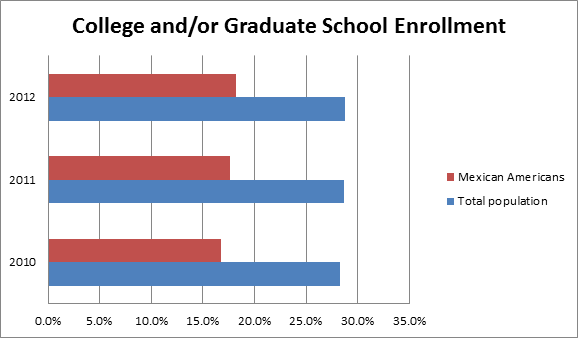
Educational attainment shows no change to the terrible numbers of 2.6 percent for the years 2010 and 2011 but there is hope in that 2012 showed a small gain to 2.9 percent.

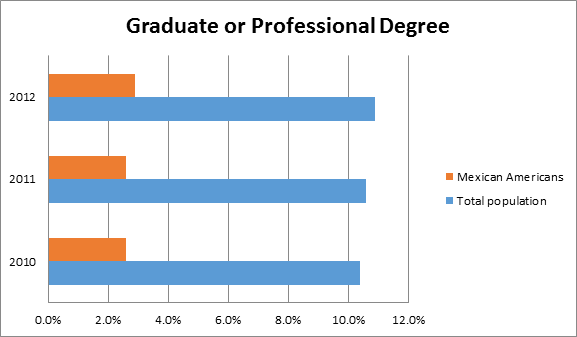
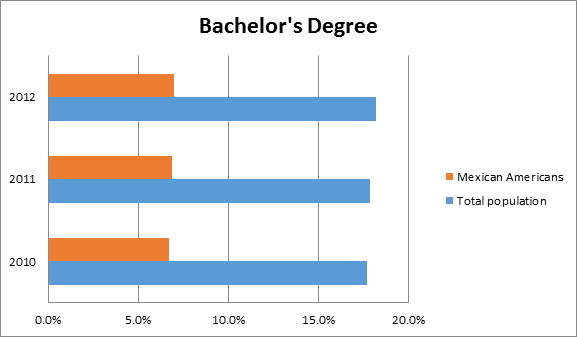
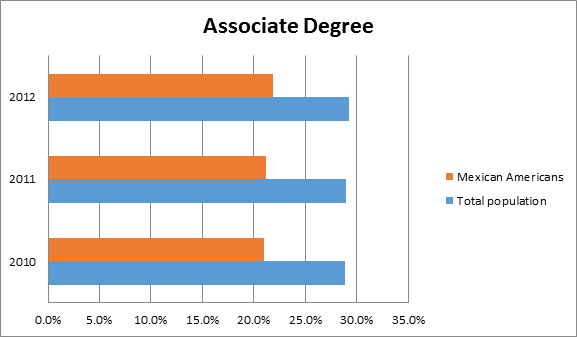
For occupations, there was a .2 percent increment yearly, but still shows that in management, business, science, and art occupations, there is still a wide gap between the total population at 36.1 percent for the year 2012 and 16.6 percent for Mexican Americans.


For professional, scientific, and management and administrative and waste management services, there is a close correlation between the percentage represented by the total population and Mexican Americans.

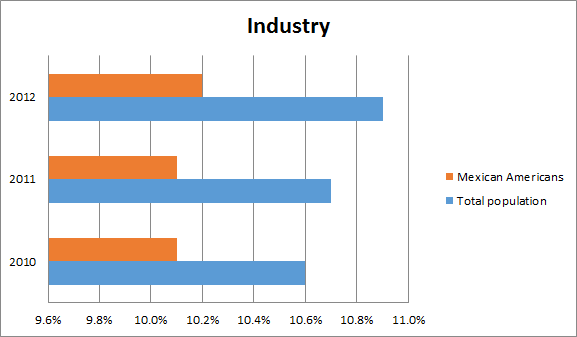
Summary:
There is hope at the end of the tunnel. College and university enrollment has been trending higher for Mexican Americans. Unfortunately, the percentage of students with graduate degrees stayed the same for the years 2010 and 2011, but rose a small amount in 2012. Percentages showing students with BA and AA degrees trended higher—an encouraging sign. Occupations still showed a wide margin between the total population and Mexican Americans. The Mexican American population showed a small increase in professional, scientific, and management and administrative and waste management employment while the total population showed a small but steady increase in this area.
References:
- Census Bureau, Selected Population Profile in the United States: 2010 – 2012
- United States S0201. Selected population Profile in the United States
- Population Group: Mexican and Total Population
- Data Set: American Community Survey 1-Year Estimates
Employment & Job News 2014: US Employers Hire 321,000 Employees in November; Latino Unemployment Drops Slightly
Employment & Job News 2014: US Employers Hire 321,000 Employees in November; Latino Unemployment Drops Slightly
U.S. employers hired 321,000 people in November, the latest sign of steady growth and health job gains. The latest job figures mean 2014 is on track to be the strongest year for hiring since 1999, and 10 million jobs were lost during the financial crisis in 2008.
More jobs, 44,000, were added in September and October than had previously been estimated. The Department of Labor said the unemployment rate remained at a six-year low of 5.8 percent.
Economy analysts say job gains will accelerate improvement in the labor market as more industries participate in the recovery. The Labor Department measured a 69.7 percent rate increase in its Diffusion index which measures industry payrolls…
Link to article
Hopeful Gains in Higher Education for Mexican Americans
By Humberto Gutierrez
Edited by Kristen House
The latest figures from the 2013 American Community Survey show progress in the wide gap between the total US professional population and Mexican Americans:
- 2012 college and/or graduate enrollment was 28.8% for the total population but only 18.2% for Mexican Americans.
- 2013 college and/or graduate enrollment was 28.3% for the total population, 18.1% for Mexican Americans, and 33.3% for foreign-born Mexican Americans.
College enrollment for the total population has decreased from the years 2012 to 2013 by 463,000 according the Census Bureau as stated in their Sept. 24, 2014 press release.
For Mexican Americans, there was also an enrollment decrease, but not as pronounced. Mexican American enrollment dropped by only .1% whereas for the total population, there was a .5% drop in college enrollment.

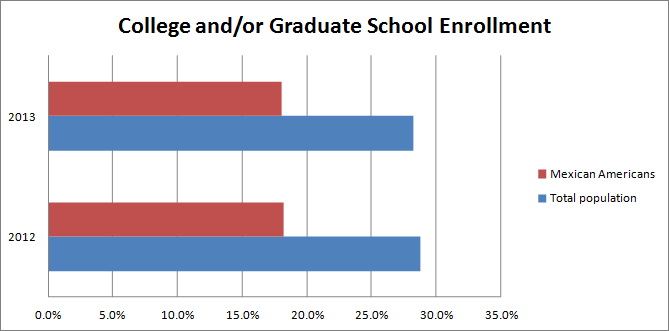
EDUCATIONAL ATTAINMENT
Educational attainment for the general population has risen by .3% from the years 2012 to 2013. For Mexican Americans, it has decreased by .1%
Earned bachelor’s degrees for the general population have risen by .2% and a bit more for Mexican Americans at .3%
Associate degrees and/or some college has shown little change across the board.
Unfortunately, only 2.8% of Mexican Americans and 1.5% of foreign-born Mexican Americans completed a graduate or professional degree in 2013. This is an extremely low percentage because the total population completion of a graduate or professional degree in 2013 was 11.2%. Why are Mexicans and native-born Mexicans not obtaining their graduate degrees? While only 7.3% of Mexican Americans have B.A. degrees, many are settling for associate degrees—21.8% of Mexican Americans and 12.1% of foreign-born Mexican Americans are ending their academic careers upon achieving these two-year degrees, according to the 2013 data.
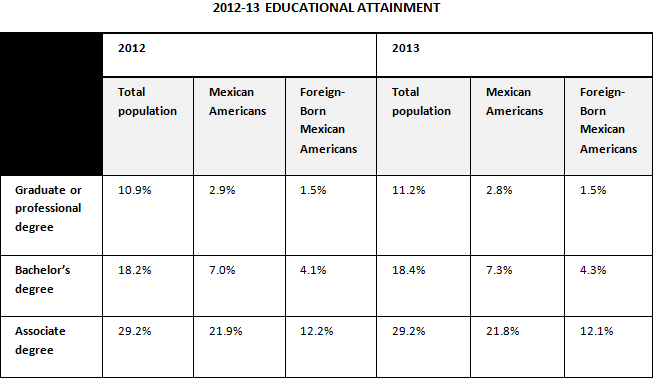

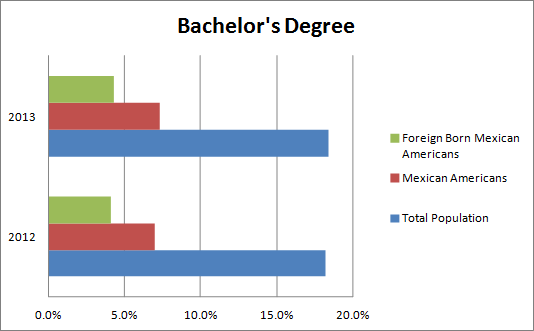
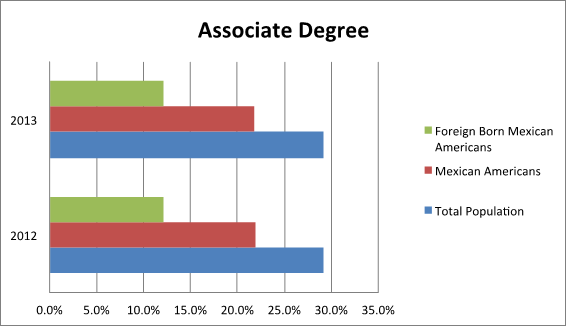
OCCUPATIONS
For the year 2013, the data for civilian employed population 16 years and over in management, business, science, and arts occupations is: 36.3% for the total population, 16.7% for Mexican Americans, and 9.2% for foreign-born Mexican Americans. Again, dismal figures.
Compared to the 2012 results, which were for the total population of 36.1% and for Mexican Americans 16.6%, there was a .2% increase for the total population and .1% for Mexican Americans. There was also a .2% increase for foreign-born Mexican Americans. Not much change, but some hope.
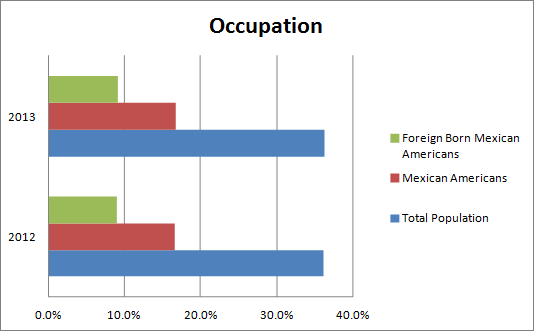
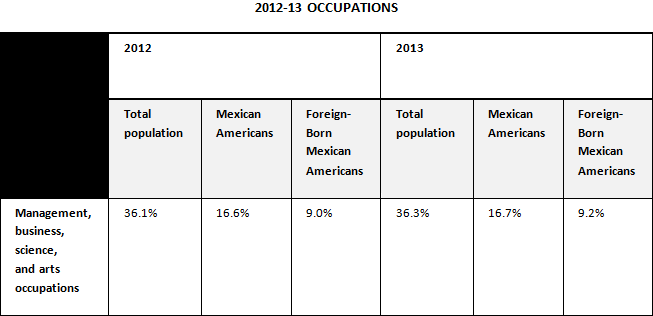
INDUSTRY
For professional, scientific, management and administration, and waste management services, 2013 employment for the total population was 11.1% and 10.2% for Mexican Americans, with foreign-born Mexican Americans at 11.5%. The 2012 results were for the total population 10.9% and 10.2% for Mexican Americans with the foreign-born Mexican Americans at 11.6%. No change for Mexican Americans and a .2% increase for the total population. However, a happy surprise: in 2013, foreign-born Mexican Americans topped all groups at 11.5% with a small decrease from 2012.
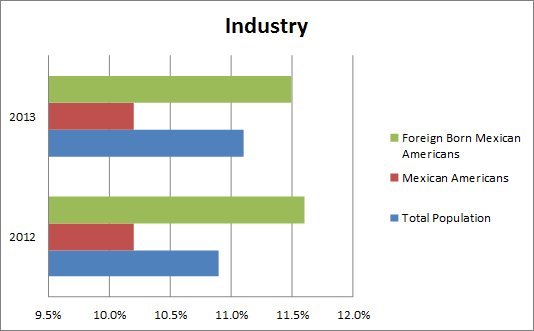
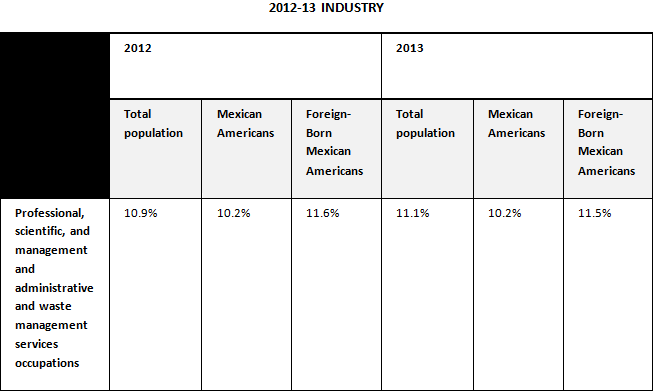
This represents a mixed picture for Mexican Americans and for foreign-born Mexican Americans in their quest for parity with the total population.
Solution for Retaining Minority Students in Higher Education
Scott Watson Swail’s 2003 report (1) on student retention programs in higher education states that a comprehensive student retention program should:
- rely on proven research
- suit the particular needs of the campus
- be institutionalized and become a regular part of campus service
- involve all campus departments and all campus personnel
- take into consideration the dynamics of the change process and provide extensive and appropriate retraining of staff
- be student centered
- operate in a cost-effective way, and not be tied to soft monies
- have the support of a comprehensive student monitoring system that will become the foundation of all institutional research on campus and support every department
- be sensitive to student needs and to diverse populations.
At least some of the above recommendations would go a long way to encourage many minority students to continue their higher education by obtaining a graduate or professional degree.
Berkley, Stanford, UCLA, and Caltech collaborate to boost minority Ph.D. students by recruiting underrepresented students in mathematical, physical and computer sciences, and in engineering.
UC Berkley put it best: “The four schools are creating a unique, cross-institutional community of underrepresented minority Ph.D. students, postdoctoral scholars, and faculty members in the targeted fields; developing faculty training to better recognize and help these students thrive and advance; and conducting research that includes annual surveys of Ph.D. students about what factors impact their attitudes, experiences and preparation for the future.”(2)
References
- Census Bureau, Selected Population Profile in the United States: 2012 and 2013
- United States S0201 and B 05006. Selected population Profile in the United States
- Population groups: Mexican and Mexico (foreign-born)
- Data set: American Community Survey 1-Year Estimates for years 2012 and 2013.
- Census Bureau, American Fact Finder, Selected population Profile in the Untied States.
————————————————–
(1) Watson Scott Swail, Retaining Minority Students in Higher Education: A Framework for Success, George Washington University, 2003
(2) Gretchen Kell, “Berkeley, Stanford, UCLA, Caltech unite to boost number of minority Ph.D. students, faculty,” UC Berkley News Center, February 13, 2014
Latinos moving up to own, run farms
WATSONVILLE, Calif. — When he was 15, an immigration raid at a Japanese flower nursery turned Arturo Flores’ life around. The owners needed a new group of workers to replace the ones removed by immigration officials, and Flores landed a job cutting flowers.
He slowly worked his way up to packaging and delivering them. In the mid-1980s, he got a call from two businessmen looking to start their own cut-flower business. They asked him to manage deliveries and distribution. Today Flores, 50, is the president of Central California Flower Growers in Watsonville, a distributor in Santa Cruz County that sells more than 100 varieties of flowers and other plants…
Link to article


